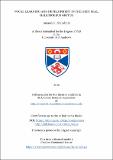Files in this item
Vocal learning and development in the grey seal, Halichoerus grypus
Item metadata
| dc.contributor.advisor | Janik, Vincent | |
| dc.contributor.author | Stansbury, Amanda | |
| dc.coverage.spatial | xvii, 273 p. | en_US |
| dc.date.accessioned | 2015-07-08T11:34:41Z | |
| dc.date.available | 2015-07-08T11:34:41Z | |
| dc.date.issued | 2015-06-24 | |
| dc.identifier.uri | https://hdl.handle.net/10023/6929 | |
| dc.description.abstract | Animal communication systems are complex, but in many species relatively little is known about how they develop. Insight into the development of adult repertoires, considering how factors such as genetics, environment and learning contribute to signal changes, provides a more comprehensive understanding of communication. This thesis documented vocal learning and development in the grey seal. In chapter 3, vocal repertoires of grey seal pups were recorded from birth through their first year, and were compared to calls of other seals across life stages, from pups to adults. By examining call parameters that were similar in animals of the same age, size, and sex, changes that may be attributed to physical development and morphology were identified. Past studies have indicated that seals may also have advanced vocal learning abilities, however the extent of these capabilities was unknown. In this thesis, vocal learning in juvenile grey seals was tested considering both how the seals learn to produce calls as well as gain information from perceived sounds. In chapter 4, grey seals were shown to be capable of vocal usage learning by producing specific calls in specific contexts. In chapter 5, grey seals displayed control over the structure of their calls as they could imitate novel sound models, demonstrating vocal production learning. Lastly, in chapter 6 grey seals gained information from perceived sound signals and used them to their benefit to locate food, demonstrating acoustic comprehension learning. Adult grey seals have complex call repertoires, and in this thesis I have shown how their calls develop with physiological growth and experience, as well as how they can gain information from perceived sound signals. | en_US |
| dc.language.iso | en | en_US |
| dc.publisher | University of St Andrews | |
| dc.rights | Creative Commons Attribution-NonCommercial-NoDerivatives 4.0 International | |
| dc.rights.uri | http://creativecommons.org/licenses/by-nc-nd/4.0/ | |
| dc.subject | Grey seal | en_US |
| dc.subject | Vocal development | en_US |
| dc.subject | Vocal learning | en_US |
| dc.subject.lcc | QL737.P64S8 | |
| dc.subject.lcsh | Gray seal | en_US |
| dc.subject.lcsh | Sound production by animals | en_US |
| dc.subject.lcsh | Animal communication | en_US |
| dc.subject.lcsh | Learning in animals | en_US |
| dc.title | Vocal learning and development in the grey seal, Halichoerus grypus | en_US |
| dc.type | Thesis | en_US |
| dc.contributor.sponsor | Natural Environment Research Council (NERC) | en_US |
| dc.type.qualificationlevel | Doctoral | en_US |
| dc.type.qualificationname | PhD Doctor of Philosophy | en_US |
| dc.publisher.institution | The University of St Andrews | en_US |
| dc.identifier.doi | https://doi.org/10.17630/10023-6929 |
This item appears in the following Collection(s)
Except where otherwise noted within the work, this item's licence for re-use is described as Creative Commons Attribution-NonCommercial-NoDerivatives 4.0 International
Items in the St Andrews Research Repository are protected by copyright, with all rights reserved, unless otherwise indicated.


